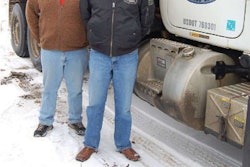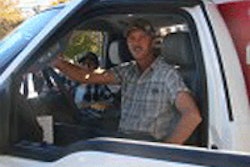A Big Market
More players jump in to a North American HDD market increasingly focused on maxi-rigs
Big opportunities are leading to demands for big equipment in the directional drilling market. At this fall’s International Construction and Utility Equipment Exposition (ICUEE), maxi-rigs generated the most attention.
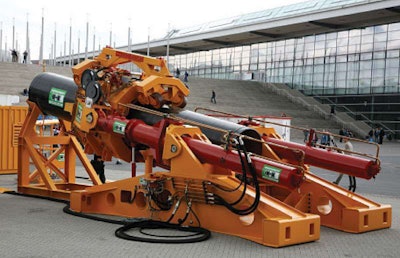 With Herrenknecht’s new auxiliary Pipe Thruster installed at the destination hole, large horizontal directional drilling units can generate even more push and pull power – up to 500 metric tons’ worth. It is suitable for pipes from 20 to 48 inches in diameter.
With Herrenknecht’s new auxiliary Pipe Thruster installed at the destination hole, large horizontal directional drilling units can generate even more push and pull power – up to 500 metric tons’ worth. It is suitable for pipes from 20 to 48 inches in diameter.HDD Broker’s Bob Martin notes strong demand for large maxi-rigs in the Northeast, specifically in connection with Marcellus Shale natural gas developments. An online service specializing in HDD sales, HDD Broker has an overall current inventory reduced by close to 30 percent compared to last year, says Martin, but utility drilling units ranging 40,000 to 150,000 pounds in maximum pullback are not the ones in demand at this time.
The Marcellus Shale, containing a large tract of untapped natural gas stretching from New York State to West Virginia, has sparked a sudden rush of drilling and related site work in economically-challenged regions notably in rural Pennsylvania. At press time, Universal HDD was commissioning the very first unit of its new 250×400 – its largest long-range model – in the region.
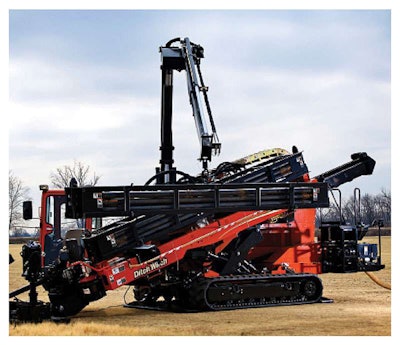 The largest Ditch Witch horizontal directional drill model, the JT100 comes in Mach 1 and All Terrain versions, both available with an optional onboard crane designed to eliminate the need on site for supporting lift equipment.
The largest Ditch Witch horizontal directional drill model, the JT100 comes in Mach 1 and All Terrain versions, both available with an optional onboard crane designed to eliminate the need on site for supporting lift equipment.The new UNI 250×400 will compete in the class of machines ranging 200,000 to 500,000 pounds in maximum pullback. With the first or only number in North American model nomenclature representing pullback in thousands of pounds, established competitors in this range include the Barbco BD250-TK, Vermeer D330x500 and, at either end of the range, American Augers DD-220T and DD-440/440T. Microprocessor-controlled with an interchangeable Tier 3/Tier 4 Cummins engine, the new tracked DD-220T is one of three newly updated models in the full-range American Augers HDD product line. It is, says the Astec-owned company, ideal for small- to mid-size utility construction and mid-range pipeline projects.
American Augers was the first HDD manufacturer to move from the use of chain to a rack-and-pinion carriage design, now the industry standard for its smooth movement, precise operating control, long system life and avoidance of complicated parts.
The Marcellus Shale has sparked a sudden rush of drilling.
Ranging to the largest North American-sourced model, the D1320x900 Navigator, “the Vermeer lineup offers cost-efficient drill performance on the jobsite with appropriately-matched torque and push/pull power, enhanced with features such as the Firestick drill rod and self-contained operation,” says Jason Zylstra, marketing manager. “Climate-controlled cabs feature good visibility and fingertip controls on the electronic joysticks.”
Ditch Witch, a longtime neck-and-neck competitor to Vermeer in the smaller utility range, tops its product line with its two JT100 models offering 100,000 pounds of maximum pullback (see Machine Matters Roundup, page 24).
World market
HDD Broker has seen an increase in international business, claiming 40 percent of its audience from outside the United States, says Martin. “Our goal is to open up the market to a global scale,” he says. “In some parts of the world, some were charging a premium because most units were U.S.-made.” Surcharges from some overseas markets have run as high as 30 percent, he says.
The opening up of the world market is not all outward bound from North America, however. Among the companies turning heads at ICUEE in Louisville, Kentucky, was Germany-based Herrenknecht, which offers models up to about 1.32 million pounds in maximum thrust/pullback, competing at the extreme large end against the established likes of Vermeer, Barbco and American Augers.
“The combination with new technologies like the Pipe Thruster enables the contractor to increase the application range of their HDD rigs to install even longer and larger crossings,” says Christoph von Büdingen, Herrenknecht marketing and corporate communications director. “The total push-pull force can be more than doubled depending on the rig selected.”
Deployed at the exit point on underground drilling jobs to add a push force to the pull of the HDD rig, the Pipe Thruster can also be used for ashore thrusting on sea projects and as a rescue tool for pipelines stuck in tough geological conditions. Possible are drill lengths of 3,000 meters or close to 10,000 feet, as well as an increased use of 48-inch pipe, says Herrenknecht. Due to a claiming device, the Pipe Thruster can even be installed when the pipe pullback is already in progress.
Another newcomer to North American soil will be the Prime Drilling brand, thanks to a partnership with Illinois-based TT Technologies announced this summer. With models up to the 1-million-pound-plus class, Prime specializes in complete, modular HDD drill rig systems customized to match geographical and geological conditions.
With the Marcellus Shale beckoning, it’s prime time for large HDD units.
ROUNDUP
American Augers
Via its American Augers brand, Astec offers a line of directional drills ranging from a mid-size product family, including the DD-10 model with 100,000 pounds of maximum thrust and pullback, up through a six-model Max-Rig line topped off by the DD-1100 RS, boasting 1.1 million pounds of maximum thrust/pullback. The newest addition to the product family is the 765-horsepower RS – or Rapid Setup – version of the DD-1100, which installs in seven simple steps after the trailer is backed in, rather than pulled in to the drilling position. Rod loaders and power units equipped with Quiet-Pak are optional. Among models newly updated are the DD-220T, combining the jobsite maneuverability of a tracked configuration with a microprocessor-controlled 220,000 pounds of maximum pullback/thrust, and the self-contained DD-10 that, says the company, boasts the most rotary torque in its mid-size class. At the DD-440 size, offering 440,000 pounds of maximum pullback/thrust, American Augers offers both trailer-mounted and tracked models.
For product info, visit: americanaugers.com/www/docs/3/products.html
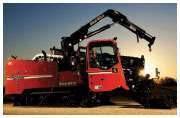
At the large end of its mainline commercial horizontal directional drill (HDD) lineup, Ditch Witch offers both the Mach 1 and newer All Terrain versions of its JT100, each boasting 100,000 pounds of maximum pullback and 70,000 pounds of maximum thrust for longer bores and installing large-diameter pipe. A machine version also offered by Ditch Witch in smaller model sizes, the All Terrain configuration features a two-pipe rack-and-pinion drilling system that enables operators to drill and steer simultaneously. Ensuring the pipe supply is never empty, drill pipe can be transferred from one box to another – and the upper box can be added or removed – without additional support equipment. A dual-pivot drill frame allows the JT100 models to be positioned on varying terrain without lifting the tracks off the ground, designed to provide the required entry angle without compromising stability or operator comfort when drilling. The optional onboard crane and anchor system further reduce the onsite need for support equipment such as excavators.
For product info, visit: ditchwitch.com/trenchless/directional-drills/
Herrenknecht
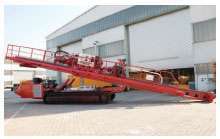 HK 150C
HK 150CA Germany-based manufacturer of massive tunnel boring machines, Herrenknecht additionally serves the HDD market with a product line topped off by the HK 600, rated at 600 metric tons or about 1.32 million pounds of maximum thrust/pullback. From 100,000 pounds up, each of the HK 100, HK 150, HK 250, HK 400, HK 500 and HK 600 model sizes are available in any of four configurations – F for frame-rig, T for trailer-rig, C for crawler-rig and M for modular-rig. The most recently updated models include the HK 150 T/C, HK 250 T/M, HK 400 T/C/M and HK 500 T. The rig design of all models and configurations – tailored to project requirement – is designed to lead to fast installations in difficult ground conditions. In case problems do occur, a self-diagnosing system immediately identifies the issue and relays the information to the operator. If the operator requires additional support, Herrenknecht’s in-house support team can dial onto the machine’s system via a remote diagnosing link. Data logging systems allow control of the operation and post-installation followup.
For product info, visit: herrenknecht.com/process-technology/machine-technology/hdd-rig.html
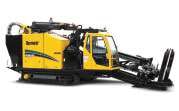
Ranging from the D100x120 Series II Navigator to the D1320x900 Navigator, Vermeer’s HDD product line rated at 100,000 pounds maximum thrust/pullback and up is covered by seven models topped off the market’s largest at 1.36 million pounds. A new model, the D100x140 Navigator offers a larger-torque alternative at the 100,000-pound maximum thrust/pullback size for utility gas, water and sewer line installations. Powered by a 275-horsepower Caterpillar Tier 4 Interim engine, the D100x140 is rated at a maximum 14,000 foot-pounds of rotational torque – 2,000 more than Vermeer’s long established model in this class. This translates into maximum rotational speeds of 205 revolutions per minute, transferring more power downhole to boost machine productivity. Two large color digital displays – the first, an integrated multifunction locator; the other, a machine and engine performance data monitor – are positioned near the drill operator’s line of sight down the bore path. With the new unit, operators can also expect mud pump flow of 230 gallons per minutes, the company says.
For product info, visit: 2.vermeer.com/vermeer/NA/en/N/equipment/directional_drills
Safety in a Vacuum
Vacuum excavation systems offers alternative ways for contractors to root out buried services
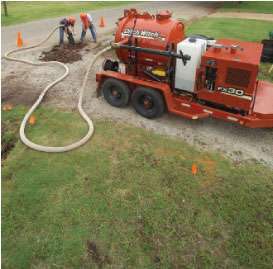 Vacuum excavation systems, such as the Ditch Witch FX30, “minimize damage to buried utilities by safely exposing underground systems with soft excavation,” says Jason Proctor, Ditch Witch heavy equipment product manager.
Vacuum excavation systems, such as the Ditch Witch FX30, “minimize damage to buried utilities by safely exposing underground systems with soft excavation,” says Jason Proctor, Ditch Witch heavy equipment product manager.Compared to a backhoe loader, hydraulic excavator or even good ol’ hand digging, the air-vacuum excavation system offers contractors a faster, more economical way to expose buried utilities, says a leading manufacturer. “Most importantly,” adds Vacmasters’ Trevor Connolly, “it’s safer.”
High-pressure air in combination with a powerful vacuum is used to first break up the soil and then remove it, enabling a trench or pothole to be dug. The spoils remain dry for prompt use as backfill once the utility is located.
“When air hits something solid such as a buried utility, it will compress and flow around it,” says Connolly, vice president of sales and marketing. “Water, on the other hand, being non-compressible, will try to cut right through it. That is why water is used to cut sheet steel and air is not.
“One of the major problems with water is that it is very indiscriminate in what it cuts – the soil or a buried utility.”
Dave Gasmovic, president and chief executive officer of McLaughlin, says both air and water can be effective in potholing – the process of locating and excavating buried services such as gas and water. Operators, he says, can select the amount of air or water pressure depending on the utility. For instance, a lower pressure will prevent damage to gas or fiber line coating, but is not necessary on water lines.
“One of the major problems with water is that it is very indiscriminate in what it cuts – the soil or a buried utility.”
“We find clients start coming up with different ways to use it,” he says. “It might have been bought to just clean out water valve boxes, but soon the sewer department’s borrowing it to clean out basins and the electric department is borrowing it to expose electric lines.
“The vacuum excavator has come of age.”
McLaughlin is a longtime strategic partner of horizontal directional drill (HDD) manufacturer Vermeer, under whose brand McLaughlin vacuum excavation systems go to market. It was announced last month that Vermeer has taken a minority equity position in McLaughlin.
Ditch Witch offers vacuum excavations systems “as a nice complement to our directional drills by providing jobsite cleanup of drilling fluid for continuous operation,” says Jason Proctor, heavy equipment product manager. “The vacuum is also used to expose buried utilities for absolute verification.”
As Gasmovic puts it, “not taking the time to visually locate underground lines can have detrimental effects on the safety of your crew and could impact your company finances with heavy fines and repair expenses for hitting an existing underground line.”
A powerful solution
Connolly recommends utility contractors thoroughly study the pros and cons of potential excavation solutions, paying particular attention to the balance between economic and safety factors. Vacmasters is among several manufacturers offering expanded product lines (see Machine Matters More Roundup, starting on this page).
“It is important to understand that it takes more horsepower to dig a hole with air than it does with water,” says Connolly. “This is because air is a ‘soft’ compressible gas and water is a ‘hard’ non-compressible fluid.
“Air systems work by delivering supersonic air from the air lance while still in a compressed state. The compressed air then travels into all the porous spaces in the soil and begins to expand. The process breaks apart – or literally explodes – the soil from within while the operator is simultaneously vacuuming up the spoils,” he says. “Conversely, water works by cutting the soil and turning it into mud.”
There are two sides to the coin, says Gasmovic. “Water-based units typically dig faster through a wide variety of spoil types and reduce the volume of the displaced material. However, the displaced spoil is wet and cannot be returned to the site immediately,” he says. “While spoil from air systems can be directly returned to the site, these systems do not cut as well in hard ground conditions such as clay.
“Some manufacturers offer the advantages of both systems in one package, which allows the user to decide if wet or dry excavation is best, based on the project at hand.
Gasmovic encourages contractors to pay special attention to the vacuum pump to make certain “the heart of the vacuum” is of good quality, and the filtration system to ensure it will filter the spoil and avoid clogging. “They should also select a tank that has the capacity to hold a half-day’s worth of spoil,” he says. “This will reduce the number of trips you need to make to dump the holding tank.”
ROUNDUP
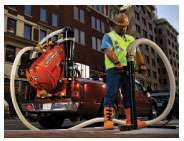
With four models including the new FX25, Ditch Witch offers vacuum excavator systems up to the trailer-mounted, 60-horsepower FX60, available with a maximum 1,200-gallon-capacity vacuum tank. At the other end, the compact FX20 has the suction power of the FX30, yet can be transported with a trailer or even on a skid in the bed of a pickup truck. The spoils tank is permanently mounted at 45 degrees for quick, easy dumping. With fully-enclosed and insulated power packs, the diesel-powered FX30 and FX60 are the quietest operating systems in their respective classes, says Ditch Witch. The FX25 uses many components common to the FX30, but has a simple, open layout powered by a commercial-grade, 31-horsepower gas engine, resulting in similar performance in a lower-cost package.
For product info, visit: ditchwitch.com/vacuum-excavation/
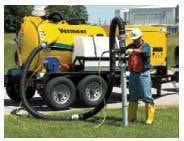
Introduced on trailer-mounted systems by McLaughlin, including the new low-profile V500 model, a three-stage filtration system allows for both wet and dry vacuum excavation, and offers wear and efficiency advantages over bag house systems, the company says. As material enters the tank at 130 miles per hour, larger soil particles lose velocity and fall out. The air then moves to a pre-filter cyclone, where remaining particles drop into a collection tank. The pre-filtered air then enters a washable, micron-poly filter that traps leftover fine particles. Should the filter suddenly need replacing, a trip to a local auto parts store to purchase a paper filter will keep the unit working for the day. A full line of vacuum excavators by McLaughlin, affiliated with minority owner Vermeer, ranges 100 to 1,200 gallons in spoil capacity.
For product info, visit: mightymole.com/index
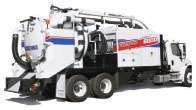
With the ability to trench in addition to pothole, the System 6000 will pull double duty at the jobsite, says Vacmasters, claiming the new truck-mounted model as the world’s most powerful air-vacuum excavation system. The additional role comes courtesy of an 80-percent increase in power compared to the System 4000, that Vacmasters says still allows contractors to pothole using air in the most difficult soil conditions “at least 95 percent of the time.” The System 6000 uses supersonic air from Vacmasters’ proprietary nozzle to penetrate, expand and explode the soil from within while keeping it dry for easy vacuuming and backfilling. The unit can dig a 12-inch-by-12-inch-by-5-foot pothole in three to five minutes. Vacmasters also offers the smaller System 3000 and 1000, the latter installed on a trailer, truck or skid.
For product info, visit: vacmasters.com/airsystems.html
Vacall
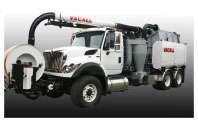 AllJetVac P Series
AllJetVac P SeriesDesigned, built and supported by fellow Alamo Group member Gradall, Vacall vacuum systems include industrial vacuum loaders, hydro excavators and catch basin cleaners. The newest product intro is the AllJetVac P Series combination sewer cleaner managed by the AllSmartFlow CAN-bus control system, located inside a protective cabinet and monitored via a LCD unit. Wired or wireless, a fully-proportional pendant allows the operator to control boom and reel movements away from the chassis. The telescoping boom reaches out 8 feet 6 inches, and debris and water tank capacities range up to 12 cubic yards and 1,500 gallons respectively. An optional flush system cleans the interior without operator assistance. Also available are backup hose reel hydraulics, multiple blowers and water pumps, and a cold water recirculation system.
For product info, visit: vacallindustries.com/products/alljetvac-combination-sewer-cleaners.php




